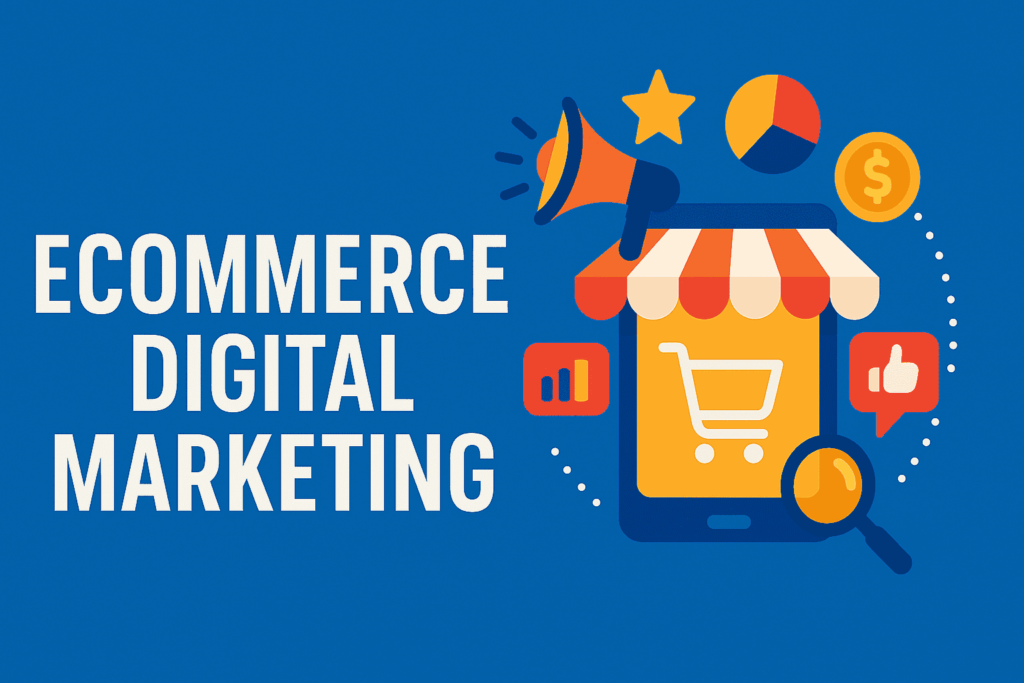Table of Contents
Let’s be honest—running an online store isn’t always easy.
You can have amazing products, a sleek website, and big dreams—but if people don’t know your store exists, you’re stuck. That’s where ecommerce digital marketing comes in.
Think of it as your online megaphone. It’s how you attract new shoppers, keep them engaged, and turn one-time buyers into loyal customers.
But here’s the good news: you don’t need a huge budget or a big team to succeed. In this guide, I’ll walk you through seven down-to-earth ecommerce digital marketing strategies that actually work in 2025—no jargon, no fluff.
1. Be Found on Google (SEO Still Works!)
Let’s start with the basics. When someone searches for “handmade soy candles” or “affordable phone cases,” you want your store to show up, right?
That’s where Search Engine Optimization (SEO) comes in.
Here’s how to make your store more visible:
- Use real keywords in your product titles and descriptions
- Write clear, helpful content that answers customer questions
- Add alt text to images (Google can’t “see” photos)
- Speed up your site (no one likes a slow load time)
- Use clean URLs (like
/organic-tea-set, not/product?id=123)
When executed properly, SEO delivers consistent, cost-free traffic. And in the world of ecommerce digital marketing, that’s gold.
2. Advertise Smartly (Not Blindly)
Let’s say SEO is the slow burn. Paid ads? That’s your shortcut.
Platforms like Google, Facebook, Instagram, and TikTok offer amazing tools to get your products in front of the right people. But be careful—ads can eat up your budget fast if you’re not tracking what’s working.
Here’s how to keep it smart:
- Start small with a daily budget
- Test different images, headlines, and audiences
- Retarget visitors who browsed your site but left without making a purchase.
- Track everything—clicks, sales, bounce rate
Paid ads are a huge part of ecommerce digital marketing, especially when you’re launching something new or trying to scale.
3. Build an Email List (Yes, It Still Matters)
A lot of people think email is outdated. Spoiler: it’s not.
Email is still one of the highest-converting tools in ecommerce digital marketing. Why? Because your email list belongs to you. You’re not at the mercy of an algorithm.
How to get started:
- Offer 10% off for first-time subscribers
- Send a friendly welcome email
- Create an abandoned cart email flow—because people forget, and that’s totally normal.
- Share new arrivals, seasonal sales, or helpful tips
Tools like Klaviyo, Mailchimp, or Omnisend make it easy to automate things, so you’re not manually sending every message.
4. Use Social Media the Right Way
You don’t need to dance on TikTok (unless you want to). But you do need to be where your customers are.
Social media is a powerful part of ecommerce digital marketing—but it’s not about just posting for the sake of it.
Here’s what works:
- Behind-the-scenes videos or packaging orders
- Customer shoutouts or testimonials
- Tutorials or product demos
- Before-and-after photos (if relevant)
- Stories with polls or Q&As
And don’t forget: make it easy to shop from your posts. Use tools like Instagram Shop, Facebook Catalog, or Pinterest Pins to send shoppers straight to your product pages with just one click.
5. Partner with the Right Influencers
No, you don’t need to pay a celebrity. Micro-influencers (people with 5K–50K followers) often get way more engagement than big names—and they cost much less.
If someone already talks about topics related to your niche, they might be the perfect fit.
For example:
- A food blogger testing your organic spices
- A fitness coach wearing your activewear
- A DIY creator using your crafting tools
This is influencer marketing, and it’s a rising star in ecommerce digital marketing. Just be sure the partnership feels natural. People can spot a fake endorsement from a mile away—authenticity always wins.
6. Don’t Let Visitors Slip Away (Retargeting)
Here’s a fact that might surprise you: most people who visit your website won’t buy anything on their first visit.
But that doesn’t mean they’re gone for good.
Retargeting is one of the most effective parts of ecommerce digital marketing. It lets you show ads to people who’ve already interacted with your store—like viewed a product or added something to their cart.
You’ve seen it before: you check out a backpack, then it follows you around the internet for a week. That’s retargeting.
It works. It’s not annoying when done right—it’s just smart.
7. Make the Buying Experience Effortless
Imagine someone finds your product, loves it… and then can’t figure out how to buy it. Frustrating, right?
Your website should make shopping as smooth as possible.
Here’s a quick checklist:
- Is your site fast on mobile?
- Are buttons like “Add to Cart” and “Checkout” easy to spot?
- Do you clearly mention shipping, return, and payment info?
- Are reviews visible to build trust?
- Is the cart easy to edit before checking out?
These small things make a big difference. A seamless experience can turn casual browsers into happy buyers—and that’s the ultimate goal of ecommerce digital marketing.
Final Thoughts: Make Ecommerce Digital Marketing Feel Like a Real Connection
The world of ecommerce changes fast, but one thing stays the same: people buy from brands they trust.
Ecommerce digital marketing isn’t about spamming people with ads or stuffing your site with keywords. It’s about showing up where your customers are, being helpful, and making their journey smooth.
So if you’re feeling overwhelmed, here’s the simple version:
- Get found (SEO)
- Get seen (ads + social media)
- Get remembered (email + retargeting)
- Get loved (great UX + influencer partnerships)
You don’t have to do everything at once. Pick one area, start experimenting, and grow from there.
Your online store deserves to be seen—and with the right approach to ecommerce digital marketing, it absolutely will be.

